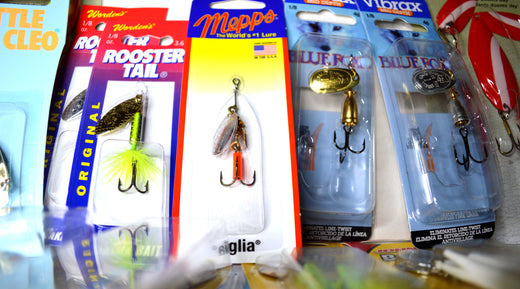
All That Glitters: A Guide to Metal Fishing Lures
Neil ColicchioShare
This post will be the first in a series of posts about lure selection. While I don't claim to be a master angler, I spend a lot of time reading about improving my fishing skills and maximizing my chances of success. One thing that has consistently worked in my favor is keeping a selection of metal or metallic lures in every tackle tray.
Metal fishing lures have long been essential to the freshwater tackle box, offering benefits in myriad fishing environments and conditions. These lures come in various shapes, sizes, and colors designed to mimic the natural movement and appearance of prey fish.
Among the most common designs of metal fishing lures are spoons, spinners, and blade baits. The concave shape and fluttering action of spoons make them ideal for targeting predatory fish like trout, salmon, and bass. Spinners feature a rotating blade that emits vibrations and flashes, drawing in fish in murky waters or low-light conditions. The slender profile and vibrating action of blade baits make them best suited for vertical jigging and deep-water fishing for anglers targeting walleye, pike, and other deep-dwelling species. Even the most popular crankbaits and jerkbaits offer shiny, metallic finishes.
The choice of metal lure material—silver, gold, or bronze—often depends on the prevailing fishing conditions. Silver and chrome lures' bright, reflective surface makes them most effective in clear water and under sunny skies, where they mimic the natural glimmer of baitfish scales. Gold lures have a warm hue and a more subtle shimmer, which excels at attracting predatory fish in stained murky waters. Bronze lures offer a subdued finish that some anglers believe to be a versatile, reliable choice for all-around fishing.
Lure design and fishing technique are the key factors to consider when selecting a metal lure. Spoons are often the best choice in open water or along the edges of weed beds, where their erratic action can trigger aggressive strikes from lurking predators. Spinners shine brightest in rivers and streams, where their rotating blades can mimic the movement of injured baitfish or insects, enticing trout and bass, among other species. Blade baits, which can be cast or fished vertically, excel in deep waters, rocky structures, and during the colder months when fish are less active but still hungry for a meal.
With so many metal lures to choose from, a few standout options have been indispensable for me. Blue Fox Vibrax Spinners are the lures that reignited my passion for fishing as a young adult, and they remain the most-used lures in my tackle box. I've caught everything from pumpkin seeds to largemouth bass on them. Spoons are my go-to lures for an after-work river fishing session or a lake trout mission at the local reservoir. They are my favorite chain pickerel lures, bar none. Last but certainly not least, rooster tail spinners are the first lures I break out when I need to cover water at a new spot. This is especially true when I'm trout fishing.
When it comes to fishing, I believe in using what works. That's why, if you were to look in my truck on any day between March and December, you'd likely find each of these lures in triplicate. I own a tackle shop, so it's in my interest to sell lures. However, I wouldn't recommend these choices unless I felt comfortable including them in my own fishing bag. So, next time you're gearing up for a fishing adventure, consider adding a few metal lures to your tackle box—they might be just what you've been missing, and I'm confident they won't disappoint. Don't just take my word for it; try them and see the results for yourself!
If I'm lucky enough to sell you any of these lures, send me a picture when you land a new PB. I'd love to feature more customer highlights on Instagram and Facebook. Until then, tight lines and happy fishing!
Neil Colicchio
Owner, New Dawn Tackle Co.



